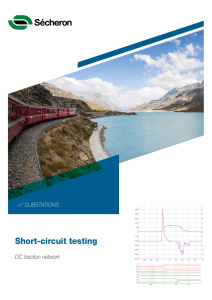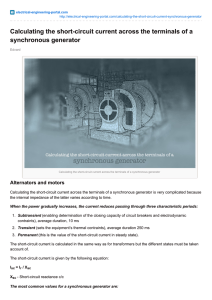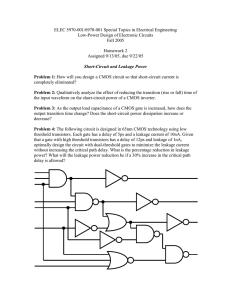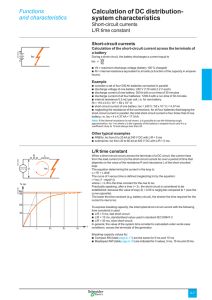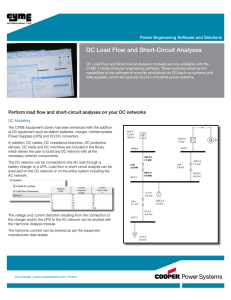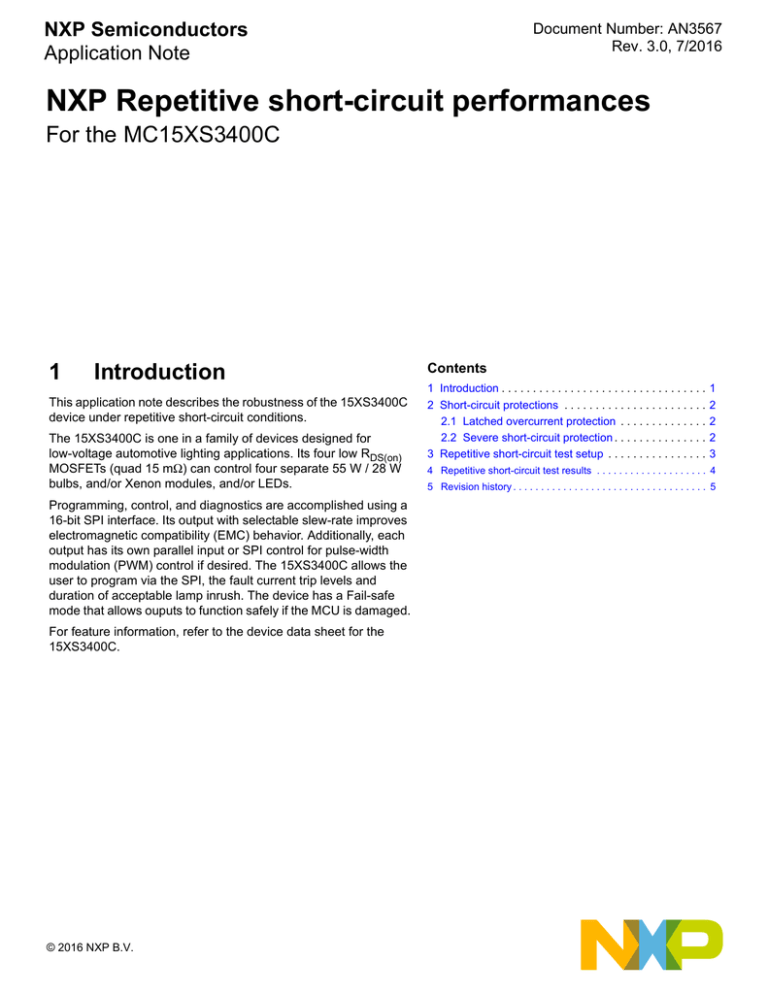
NXP Semiconductors
Application Note
Document Number: AN3567
Rev. 3.0, 7/2016
NXP Repetitive short-circuit performances
For the MC15XS3400C
1
Introduction
This application note describes the robustness of the 15XS3400C
device under repetitive short-circuit conditions.
The 15XS3400C is one in a family of devices designed for
low-voltage automotive lighting applications. Its four low RDS(on)
MOSFETs (quad 15 mΩ) can control four separate 55 W / 28 W
bulbs, and/or Xenon modules, and/or LEDs.
Programming, control, and diagnostics are accomplished using a
16-bit SPI interface. Its output with selectable slew-rate improves
electromagnetic compatibility (EMC) behavior. Additionally, each
output has its own parallel input or SPI control for pulse-width
modulation (PWM) control if desired. The 15XS3400C allows the
user to program via the SPI, the fault current trip levels and
duration of acceptable lamp inrush. The device has a Fail-safe
mode that allows ouputs to function safely if the MCU is damaged.
For feature information, refer to the device data sheet for the
15XS3400C.
© 2016 NXP B.V.
Contents
1 Introduction . . . . . . . . . . . . . . . . . . . . . . . . . . . . . . . . .
2 Short-circuit protections . . . . . . . . . . . . . . . . . . . . . . .
2.1 Latched overcurrent protection . . . . . . . . . . . . . .
2.2 Severe short-circuit protection . . . . . . . . . . . . . . .
3 Repetitive short-circuit test setup . . . . . . . . . . . . . . . .
1
2
2
2
3
4 Repetitive short-circuit test results . . . . . . . . . . . . . . . . . . . . 4
5 Revision history . . . . . . . . . . . . . . . . . . . . . . . . . . . . . . . . . . . 5
Short-circuit protections
2
Short-circuit protections
The 15XS3400C device includes four self-protected high side switches with 15 mΩ RDS(on) and extended diagnostics, in
order to detect bulb outage and short-circuit fault conditions. Moreover, this device incorporates a pulse width modulation
control module, to improve lamp lifetime with bulb power regulation at no less than 100Hz and address the dimming
application (day running light).
The 15XS3400C offers two different over-load protection features:
•
latched overcurrent protection
•
severe short-circuit protection
These protections are preferable to conventional current limitations because they minimize thermal overstress within the
device when an overload occurs. The delta (T) is drastically reduced to a value which does not affect the device’s reliability.
Moreover, the availability of the lighting is guaranteed by the limited auto-retry feature (15 retries).
2.1
Latched overcurrent protection
The transient overcurrent profile is adjustable to account for the variability in the bulb characteristics and the energy
associated with the expected wire harness current capability. The 15XS3400C incorporates multiple configurable inrush
profiles to address halogen lamps like H1, H3, H4, H7 and H9, incandescent bulbs like P27W, P21W and P21W+R5W, and
Xenon-HID modules. Coupled to a modulation control module, the transient overcurrent profile protects the application if the
lamp is driven in the PWM mode as well. Figure 1 shows an example for an H1 lamp.
Transient overcurrents are configurable using an SPI communication link between an external microcontroller and the
device. Two OCHI thresholds are available to sustain inrush current and four OCLO current levels allow optimizing cable
gage in the steady state.
100
90
80
H1 bulb current
70
Transient Overcurrent Profile
60
50
40
30
20
10
0
0
25
50
75
100
125
150
Figure 1. Transient overcurrent profile example
2.2
Severe short-circuit protection
In addition to latched overcurrent protection, a severe short-circuit detection feature immediately turns off the output if a
short-circuit is detected during lamp switching. Without this feature, the junction temperature will likely be high because the
high-side MOSFET is not yet in the RDS(on) state.
Both short-circuit conditions can be distinguished with SPI fault reports.
NXP Repetitive short-circuit performances, Rev. 3.0
NXP Semiconductors
2
Repetitive short-circuit test setup
3
Repetitive short-circuit test setup
The repetitive short-circuit tests have been performed in accordance with Chapter 12 of AEC-Q100 specification published
by the Automotive Electronics Council. The goal is to force the device to switch “on” and “off” cyclically in a short-circuit
condition in order to accelerate silicon fatigue.
Some test cases are defined in the AEC specification:
•
Hot Repetitive Short-circuit Test: an infinite “on” command,
•
Cold Repetitive Short-circuit Test-Short Pulse: a repetitive turn-on command of 10 ms periods,
•
Cold Repetitive Short-circuit Test-Long Pulse: a repetitive turn-on command of 300 ms periods.
These tests have been performed for difference short-circuit conditions, activating each overload protection feature as
described in Figure 2:
a) Terminal short-circuit of 20 mΩ (Rshort) - 8 °C delta (T) estimated,
b) Load short-circuit of 100 mΩ - 60 °C delta (T) estimated,
c) Overload condition exceeding the nominal current (i.e. 40 A DC) - 75 °C delta (T) estimated.
Load short-circuit
100
90
80
70
Terminal short-circuit
60
50
Overload condition
40
30
20
10
0
0
25
50
75
100
125
150
Figure 2. Short-circuit conditions
Figure 3 describes the hardware test setup used with Lsupply = 4 µH, Rsupply = 10 mΩ, and Lshort = 3 µH
Lsupply
Rsupply
Smart Power
High Side Device
VPWR
VBB
Ideal DC
Voltage +
_
Source
5μH
10mΩ
14V
Control
System
Lshort
Rshort
OUT
see Table 1
ON/OFF
GND
Figure 3. Short-circuit test setup
The test escape condition was severe part damage (i.e. destruction).
NXP Repetitive short-circuit performances, Rev. 3.0
NXP Semiconductors
3
Repetitive short-circuit test results
4
Repetitive short-circuit test results
Table 1 presents the summary of repetitive test results for the MC15XS3400C. 10 engineering samples were used per test.
Table 1. Test results summary
Test name
Ambient
temperature
Load
short-circuit
-40 °C
Load
short-circuit
Cycle
definition
OCHI level
configured
Fault detected
Number of cycles passed
before the first failure
ON 10 ms
OFF 990 ms
OCHI1
Latched overcurrent for 90 A
at 250 µsec
1 M cycles
drain / source shorted together
+40 °C
ON 10 ms
OFF 990 ms
OCHI1
Latched overcurrent for 90 A
at 250 µsec
382 k cycles
drain / source shorted together
Load
short-circuit
+85 °C
ON 10 ms
OFF 990 ms
OCHI1
Latched overcurrent for 90 A
at 250 µsec
73 k cycles
drain / source shorted together
Load
short-circuit
+85 °C
ON 10 ms
OFF 990 ms
OCHI2
Latched overcurrent for 65 A
at 250 µsec
> 1.2 M cycles
Overload
+40 °C
ON 900 ms
OFF 9 s
OCHI1
Latched overcurrent for 40 A
at 95 msec
> 1 M cycles
Terminal
short-circuit
+85 °C
ON 1 ms
OFF 99 ms
OCHI1
Latched severe short-circuit
for 40 A at 100 µsec
> 1 M cycles
The load short-circuit at hot temperature is the worst case.
NXP Repetitive short-circuit performances, Rev. 3.0
NXP Semiconductors
4
Revision history
5
Revision history
Revision
Date
2.0
9/2009
•
Initial release
4/2015
•
No technical changes. Revised back page. Updated document properties.
7/2016
•
Updated NXP document form and style
3.0
Description of changes
NXP Repetitive short-circuit performances, Rev. 3.0
NXP Semiconductors
5
How to Reach Us:
Information in this document is provided solely to enable system and software implementers to use NXP products. There
Home Page:
NXP.com
are no expressed or implied copyright licenses granted hereunder to design or fabricate any integrated circuits based on
Web Support:
http://www.nxp.com/support
NXP makes no warranty, representation, or guarantee regarding the suitability of its products for any particular purpose,
the information in this document. NXP reserves the right to make changes without further notice to any products herein.
nor does NXP assume any liability arising out of the application or use of any product or circuit, and specifically disclaims
any and all liability, including without limitation, consequential or incidental damages. "Typical" parameters that may be
provided in NXP data sheets and/or specifications can and do vary in different applications, and actual performance may
vary over time. All operating parameters, including "typicals," must be validated for each customer application by the
customer's technical experts. NXP does not convey any license under its patent rights nor the rights of others. NXP sells
products pursuant to standard terms and conditions of sale, which can be found at the following address:
http://www.nxp.com/terms-of-use.html.
NXP, the NXP logo, Freescale, the Freescale logo, and SMARTMOS are trademarks of NXP B.V. All other product or
service names are the property of their respective owners. All rights reserved.
© 2016 NXP B.V.
Document Number: AN3567
Rev. 3.0
7/2016

